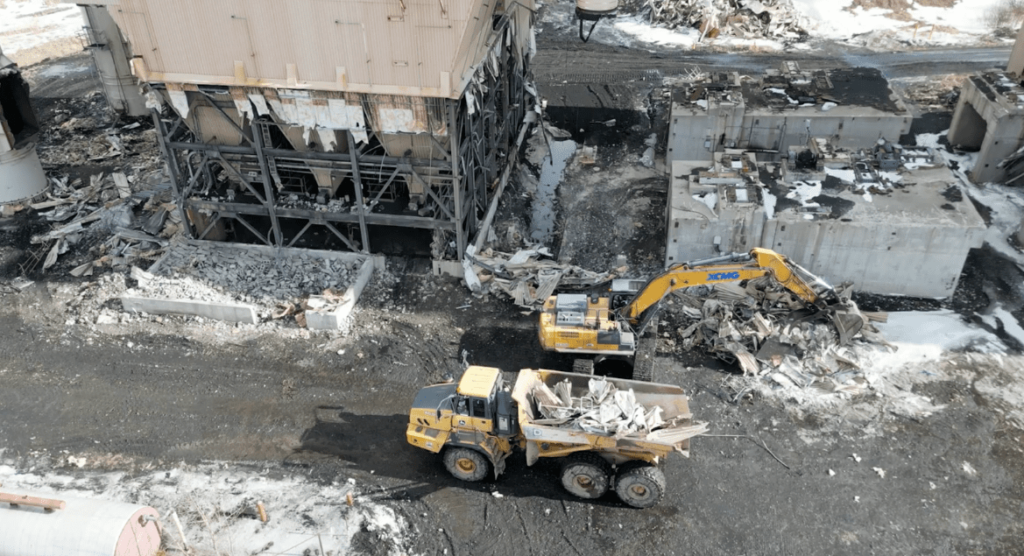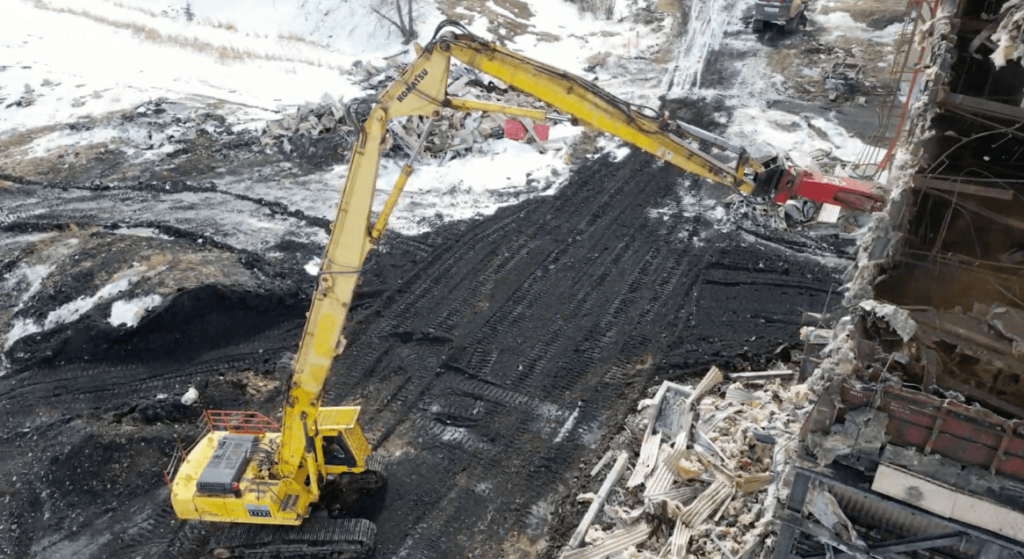Lead Paint Removal: Our Hazardous Waste Disposal & Abatement Process During Demolition
If you lived in the 1800’s, there’s a good chance your bedroom wallpaper would have contained arsenic. Those toxic ink particles and vapors would lazily float through the air, and slowly accumulate inside your body. It wouldn’t have been long before you joined the growing list of mysterious illnesses being reported.
Thankfully, we’ve learnt a lot since then about protecting our health and wellness. People no longer give whiskey to teething babies. Buildings aren’t insulated with asbestos. And lead isn’t used in makeup or paint anymore.
Even though these practices are extinct, these hazardous materials often rear their ugly heads during industrial demolition.
Lead paint is often discovered during the early phases of our demolition projects. Since the product wasn’t phased out until the 1970s, many power plants, mills, mines and other industrial buildings from before that period are likely to require lead abatement procedures.
It’s surprising that it took us that long to rid ourselves of lead-based paint. The CDC reports that “between 1925 and 1927, more commercial painters died from lead poisoning than all other occupational groups combined.” Even despite those risks, painters at the time still chose lead-based paint since it was considered vastly superior.
This article explores some important information on lead-based paint, and how we at Richmond Steel Demolition Services safely remove and dispose of it.
- What Are the Dangers of Lead Paint?
- Why In The World Were Lead-Based Paints Ever Used?!
- Could There Be Lead Paint In My Building?
- Overview of the Lead Paint Removal Process
- Safety Measures: Protecting Our Crews from Lead Paint Exposure
- Lead Paint, Our Hazardous Waste Disposal Process
- Conclusion
What Are The Dangers of Lead Paint?
Most people know that lead-based paint is dangerous, but not many people are aware of all the associated risks. Consider this excerpt from the Canadian Center for Occupational Health and Safety:
Effects of Long-Term (Chronic) Exposure: VERY TOXIC. Can cause permanent damage to the nervous system. Symptoms may include restlessness, reduced ability to think, muscle tremors, memory loss and personality changes. In severe cases, symptoms may include muscle weakness, loss of feeling or prickly sensation in the hands, feet, arms or legs, clumsiness and paralysis. Can cause permanent damage to the kidneys. In severe cases, symptoms may include fatigue, increased or decreased urination, nausea, and vomiting. May harm the blood. In severe cases, symptoms may include paleness, fatigue, weakness, dizziness, confusion, shortness of breath and headache.
The list of concerns doesn’t stop there. Here are just a few of the other potential risks:
- Neurological Damage: Lead paint exposure can cause severe neurological and developmental damage, particularly in children. It can result in reduced IQ, learning disabilities, behavioral problems, and impaired cognitive function.
- Pregnancy Risks: Lead paints can affect reproductive health, causing reduced fertility in both men and women. Prolonged exposure to lead paint during pregnancy can result in miscarriage, stillbirth, premature birth, and low birth weight.
- Immune System Impairment: Over time, proximity to lead-based paint can weaken the immune system, making individuals more susceptible to infections and illnesses.
While there are government set permissible limits for lead exposure, every effort should be made to minimize contact—especially for demolition crews.

Why In The World Were Lead-Based Paints Ever Used?!
After reading that laundry list of risks and health concerns, you’re probably asking: “why was lead paint ever used?” Before all of the negative side-effects became apparent, lead paint did offer several key advantages that made it popular at the time.
- Durability: Lead-based paints were highly durable and resistant to moisture, which made them ideal for use on exterior surfaces and areas prone to wear and tear.
- Color Brightness: Lead paints provided vibrant colors and excellent coverage, requiring fewer coats compared to other paints.
- Quick Drying: Lead paints dried faster than other paints, which was beneficial for both manufacturing and construction processes.
Mold and Mildew Resistance: Lead has antimicrobial properties that helped prevent mold and mildew growth on painted surfaces.
Could There Be Lead Paint On My Site?
Earlier, we mentioned the phasing out of lead-based paints began in the 1970’s in Canada. This phasing-out process however took several decades.
In Canada, it took until the 1990s for regulations to begin applying limits on lead usage in commercial and industrial paint applications. Finally, in the early 2000s, comprehensive regulations effectively banned lead in all paints (although specific industrial uses had longer timelines, but have since transitioned to safer alternatives).
Buildings constructed before the mid-nineteen seventies are more likely to have lead-based paint. With older buildings, the likelihood is often higher.
Lead-based paints often come with some telltale signs to watch out for:
- Peeling or Chipping Paint: If you notice paint that is peeling, chipping, or cracking, especially in older buildings, it could be lead-based paint.
- Layers of Paint: If you notice multiple layers of paint, with older layers being particularly thick, it might indicate the presence of lead paint.
- Discolored Dust: Lead paint can produce fine dust that can settle on surfaces. If you notice discolored dust on window sills, floors, or other surfaces, it could be an indicator of lead-based paint deterioration.
The most reliable way to determine if your building has lead paint is through professional testing. Methods such as X-ray fluorescence (XRF) can be used, which can detect lead without disturbing surfaces. Alternatively, paint chip sampling, where small paint samples are analyzed in a lab for lead content, can also be a reliable indicator.
At Richmond Steel, our personal experience in demolitions has shown us that old mines, mills, oil & gas, and power facilities are often likely to contain lead paint.

Overview of the Lead Paint Removal Process: Lead Abatement
Lead abatement during the demolition of a building involves several critical steps to ensure the safe removal and handling of lead-containing materials.
The process begins with assessment and planning, identifying areas with lead-based paint and assessing the risk. Containment areas can be set up to prevent the spread of lead dust and debris; while workers are equipped with personal protective equipment (PPE) and follow our standard operating procedures (SOPs).
One of our key practices is avoiding blasting techniques, which can disperse lead dust into the air. Instead, our crews meticulously tear down structures, using precision and care. The use of shears helps to carefully tear apart materials while minimizing direct contact and reducing the risk of lead exposure.
Safety Measures: Protecting Our Crews from Lead Paint Exposure
Considering the many health hazards of lead paint, Richmond Steel has strict procedures in place to ensure the health and safety of our crew during lead abatement. While on site, everyone is required to follow our comprehensive written guidelines and standard operating procedures at all times.
To further protect our crews, we equip them with Powered Air-Purifying Respirators (PAPR) when necessary, ensuring they have the highest level of respiratory protection. Regular blood monitoring is also conducted to track lead levels in our employees, allowing us to take immediate action if elevated levels are detected.
These are just some of the crucial safety measures used in maintaining a safe working environment and safeguarding crews as they handle lead-based materials.
Lead Paint, Our Hazardous Waste Disposal Process
Once materials are carefully removed, they are sent to our integrated mill, which is equipped to process lead-contaminated scrap metal.
At the mill, lead-contaminated materials are processed, and any lead paint on steel is burned and captured off during the melting process. Our facility features a 'baghouse' system with scrubbers that capture fumes and lead particulates released during melting. This advanced filtration system ensures that harmful lead particles do not enter the atmosphere, safely containing and managing the lead residue.
This thorough disposal process ensures that lead paint is managed responsibly, protecting both our workers and the environment from potential lead contamination.
Conclusion
Times have changed. Wallpaper might not contain arsenic these days, but there is still a large amount of lead paint to be found—especially in older industrial sites.
At Richmond Steel, our lead abatement process handles this hazardous waste disposal in a way that protects people, and our environment. If you have a demolition or material recovery project that could contain lead paint, it’s important to follow the proper procedures. Talk to our demolition specialists today and learn how Richmond Steel’s Demolition Services can guide you through the process safely and efficiently.